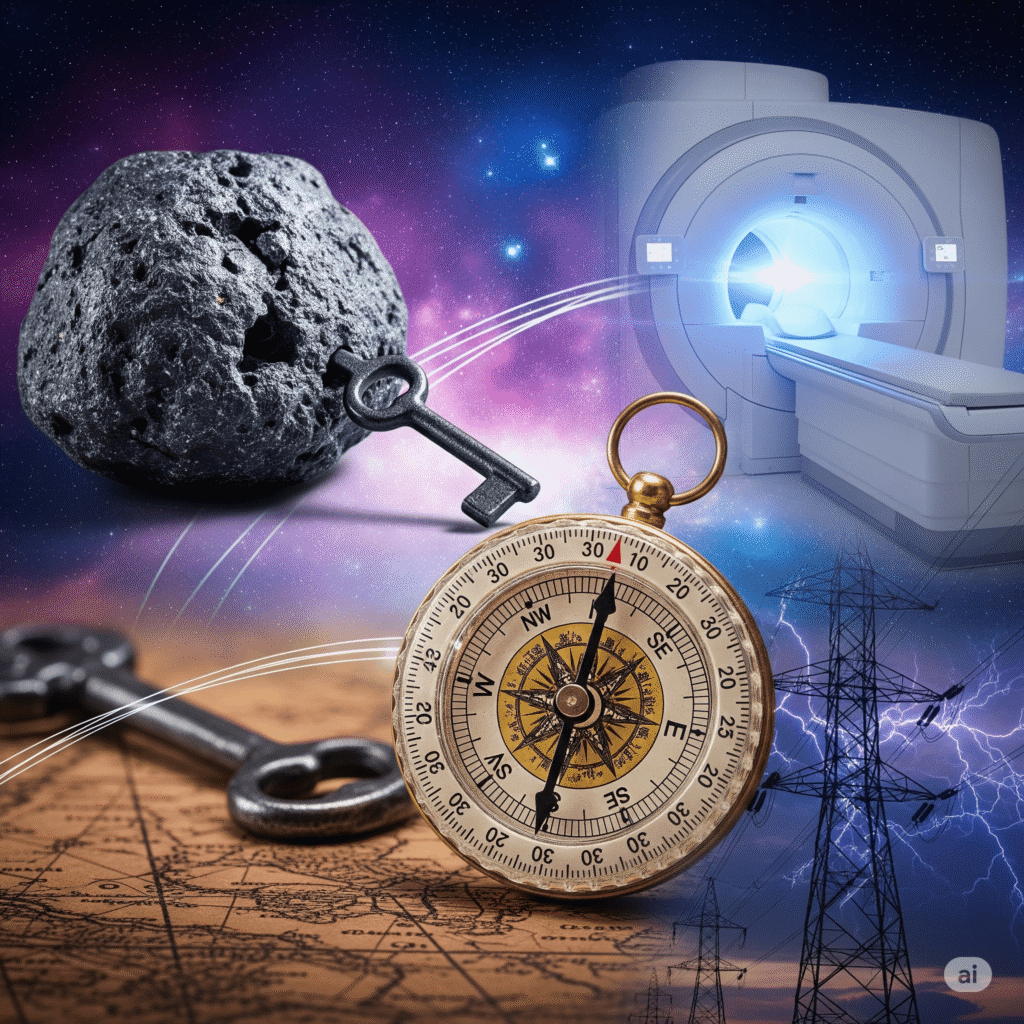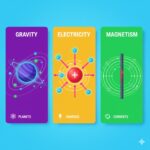
Understanding the electromagnetic revolution that transformed human civilization
The Whispers of Hidden Power 🌟
Imagine standing on an ancient Greek hillside, watching in wonder as a mysterious rock pulls iron toward itself with invisible hands. Picture Chinese sailors trusting their lives to a needle that mysteriously points north across endless oceans. For millennia, these phenomena danced on the edge between magic and reality, challenging humanity’s understanding of the natural world.
Early civilizations witnessed magnetism as divine intervention — perhaps gifts from gods or nature’s hidden tricks. Yet beneath this mystical veil lay one of the universe’s fundamental forces, waiting for curious minds to decode its secrets. This invisible, silent power would eventually reshape every aspect of human civilization, from the simple doorbell to the vast internet that connects our world.
The journey from mystical stones to unified field theory represents humanity’s greatest intellectual adventure — a testament to persistence, serendipity, and the relentless pursuit of truth that defines scientific progress

Ancient Whispers: The First Magnetic Mysteries 🏺
Our story begins around 600 BCE in ancient Magnesia (modern-day Turkey), where philosopher Thales of Miletus encountered lodestones — naturally magnetized iron ore containing magnetite (Fe₃O₄). These “magic stones” defied explanation, attracting iron with what seemed like supernatural force. Thales, grappling with this phenomenon, proposed that these stones possessed “souls” or vital essence, marking humanity’s first attempt to rationalize magnetic attraction.
The physical reality behind this ancient wonder involves magnetic domains — microscopic regions where iron atoms align their magnetic moments parallel to each other. In magnetite, approximately 10²³ iron atoms per cubic centimeter create cooperative magnetic behavior. When external magnetic fields exceed the coercive force (typically 10-100 Oersteds for natural magnetite), these domains align, creating permanent magnetization with field strengths reaching 0.1-0.5 Tesla.

Meanwhile, across the world in 11th century China, practical minds transformed magnetic curiosity into navigational revolution. Chinese artisans discovered that freely suspended lodestone needles consistently aligned north-south, creating the magnetic compass. This wasn’t mere curiosity — it was technological breakthrough that enabled global exploration and trade.
The Earth’s magnetic field that guides these compasses originates from convection currents in our planet’s molten iron outer core. Electrical currents flowing through this liquid conductor generate magnetic fields ranging from 25-65 microteslas at Earth’s surface. The magnetic declination — the angle between magnetic and true north — varies by location due to the dipole field’s complexity, something ancient navigators learned through careful observation.
For centuries, understanding stagnated. Magnetism remained isolated from other natural phenomena, surrounded by misconceptions. Some believed garlic could demagnetize compasses, while others attributed healing powers to magnetic stones. These superstitions persisted because the underlying physics required conceptual frameworks that wouldn’t emerge for another millennium.
Renaissance Revelation: Gilbert's Systematic Science 🔬
The first major breakthrough arrived in 1600 when William Gilbert, physician to Queen Elizabeth I, published “De Magnete” — a masterwork that transformed magnetism from folklore into systematic science. Gilbert spent decades conducting meticulous experiments, systematically debunking superstitions while establishing magnetism’s first scientific principles.

The first major breakthrough arrived in 1600 when William Gilbert, physician to Queen Elizabeth I, published “De Magnete” — a masterwork that transformed magnetism from folklore into systematic science. Gilbert spent decades conducting meticulous experiments, systematically debunking superstitions while establishing magnetism’s first scientific principles. Gilbert’s revolutionary insight proposed Earth itself as a giant magnet — a “terrella” or little Earth. He demonstrated this using magnetized spheres, showing how compass needles followed curved paths around them, mirroring compass behavior on Earth’s surface. His experiments revealed magnetic field lines, though he lacked modern terminology to describe them mathematically.
Gilbert distinguished between magnetism and static electricity (which he termed “electricks”), recognizing them as separate phenomena. He established that magnetic attraction follows an inverse relationship with distance, though the precise r⁻² law wouldn’t be formulated until later. His work also identified magnetic permeability differences between materials, laying groundwork for understanding ferromagnetism, paramagnetism, and diamagnetism.
The Earth’s magnetic field Gilbert studied results from the geodynamo effect — a self-sustaining process where convection in the outer core generates electrical currents of approximately 10⁹ amperes. These currents create magnetic fields that in turn influence the flow patterns, creating a feedback loop that has maintained Earth’s magnetism for over 3.5 billion years.
The Electrifying Connection: Ørsted's Accidental Revolution ⚡
For two centuries after Gilbert, magnetism and electricity remained conceptually separate. This changed forever on April 21, 1820, when Danish physicist Hans Christian Ørsted noticed something extraordinary during a university lecture preparation. While demonstrating electrical circuits, he observed a compass needle deflect whenever current flowed through a nearby wire.

Ørsted’s observation revealed the fundamental relationship between electricity and magnetism: moving electrical charges create magnetic fields. The magnetic field around a current-carrying wire follows the relationship B = μ₀I/(2πr), where μ₀ = 4π × 10⁻⁷ H/m is the permeability of free space, I represents current in amperes, and r indicates distance from the wire. With typical demonstration currents of 3-5 amperes, compass deflections reached 20-45 degrees at distances of several centimeters.
This wasn’t merely academic curiosity — it was the birth of electromagnetism. Ørsted’s discovery showed that electricity and magnetism were intimately connected phenomena, not separate forces as previously believed. The implications rippled across scientific communities worldwide, triggering an avalanche of research that would reshape human understanding of nature itself.
News of Ørsted’s discovery reached France within weeks, where mathematician André-Marie Ampère immediately grasped its significance. Ampère didn’t merely confirm Ørsted’s findings — he quantified them. Through systematic experimentation, he demonstrated that current-carrying conductors exert forces on each other, with parallel currents attracting and antiparallel currents repelling.
Ampère formulated his circuital law: ∮B⋅dl = μ₀I, which describes how electric currents generate magnetic fields. The force between parallel current-carrying wires follows F = μ₀I₁I₂l/(2πd), where I₁ and I₂ represent the currents, l is wire length, and d indicates separation distance.

This relationship defines the ampere — when two parallel wires carrying equal current experience force of 2 × 10⁻⁷ newtons per meter, each carries one ampere of current.
Faraday's Field Revolution: Seeing the Invisible 🌊
While Ampère provided mathematical precision, Michael Faraday brought revolutionary conceptual insight. This self-educated bookbinder’s son possessed extraordinary intuitive genius, visualizing invisible “lines of force” that permeated space around magnets and current-carrying conductors.
Faraday’s breakthrough came through electromagnetic induction — the discovery that changing magnetic fields generate electrical currents. His law of induction, ε = -dΦ/dt, quantifies this relationship where ε represents induced electromotive force, Φ indicates magnetic flux (Φ = B⋅A), and the negative sign reflects Lenz’s law — induced currents oppose the changes that create them.
Through painstaking experimentation, Faraday demonstrated that moving a conductor through magnetic fields generates electrical current. His rotating copper disk generator, producing continuous current through mechanical motion, became the prototype for all electrical generators. With magnetic fields of 0.1-1 Tesla and rotation speeds of 100-1000 RPM, Faraday’s early generators produced several volts — enough to power simple circuits and demonstrate the conversion of mechanical energy into electrical energy.
Faraday’s field concept revolutionized physics by proposing that forces acted through continuous media rather than mysterious “action at a distance.” His visualization of magnetic field lines as physical entities carrying energy density of B²/(2μ₀) provided the conceptual framework for modern field theory. Though lacking advanced mathematics, Faraday’s intuitive understanding of fields surpassed many of his mathematically trained contemporaries.
The practical implications were staggering. Electromagnetic induction enables every electrical generator in modern power plants, whether powered by steam turbines, water flow, or wind energy. Transformers, essential for efficient power transmission, rely on mutual inductance between coils, with voltage ratios following N₁/N₂ = V₁/V₂, where N represents turns and V indicates voltage.
Maxwell's Mathematical Symphony: Unifying the Universe 🎼
The ultimate synthesis arrived through James Clerk Maxwell, whose theoretical brilliance unified electricity, magnetism, and light into a single, elegant framework. Building upon Faraday’s insights and Ampère’s mathematics, Maxwell formulated four equations that described all electromagnetic phenomena:
∇⋅E = ρ/ε₀ (Gauss’s law for electric fields) ∇⋅B = 0 (No magnetic monopoles) ∇×E = -∂B/∂t (Faraday’s law) ∇×B = μ₀J + μ₀ε₀∂E/∂t (Ampère-Maxwell law)

Maxwell’s masterstroke was adding the displacement current term μ₀ε₀∂E/∂t to Ampère’s law. This modification, born from mathematical consistency requirements, predicted that changing electric fields generate magnetic fields — completing the symmetric relationship between electricity and magnetism.
From these equations, Maxwell derived the electromagnetic wave equation, predicting that oscillating electric and magnetic fields propagate through space at speed c = 1/√(μ₀ε₀) ≈ 3 × 10⁸ m/s. When calculated, this matched the measured speed of light exactly — revealing that light itself was an electromagnetic phenomenon!
Maxwell’s equations predicted the entire electromagnetic spectrum. Radio waves (λ ~ 1 m – 100 km, f ~ 3 kHz – 300 MHz) occupy the longest wavelengths, followed by microwaves, infrared, visible light (λ ~ 400-700 nm, f ~ 430-750 THz), ultraviolet, X-rays, and gamma rays (λ < 10⁻¹² m, f > 10²⁰ Hz). This unified framework revealed that all electromagnetic radiation follows identical wave equations, differing only in frequency and wavelength.
The Relativistic Connection: Einstein's Magnetic Insights 🚀
Maxwell’s equations possessed a profound implication that wouldn’t be fully understood until Einstein’s special relativity in 1905. Magnetism and electricity are not separate forces but different aspects of a single electromagnetic field, viewed from different reference frames.
Consider two parallel wires carrying current in the same direction. In the lab frame, we observe magnetic forces causing attraction. However, transform to the reference frame moving with the electrons, and the magnetic interaction becomes an electric force between space charges. The Lorentz transformation γ = 1/√(1-v²/c²) relates these perspectives, showing that F_magnetic = (v/c)² F_electric for typical current densities.

Consider two parallel wires carrying current in the same direction. In the lab frame, we observe magnetic forces causing attraction. However, transform to the reference frame moving with the electrons, and the magnetic interaction becomes an electric force between space charges. The Lorentz transformation γ = 1/√(1-v²/c²) relates these perspectives, showing that F_magnetic = (v/c)² F_electric for typical current densities.
Modern Applications: The Electromagnetic Revolution 🌐
Our electromagnetic understanding has spawned technologies that define modern civilization. Electrical power generation relies on Faraday’s induction principle, whether through steam turbines in thermal plants, water wheels in hydroelectric facilities, or wind generators. Large power plant generators produce 15-25 kV at frequencies of 50-60 Hz, with efficiencies exceeding 95% in modern designs.
Power transmission requires transformers that step voltages up to 100-800 kV for efficient long-distance transport. Transformer efficiency follows η = P_out/P_in, with modern units achieving 98-99% efficiency. The relationship V₁/V₂ = N₁/N₂ allows voltage transformation while maintaining power conservation: V₁I₁ = V₂I₂ (neglecting losses).

Electric motors convert electrical energy to mechanical work through magnetic forces on current-carrying conductors. The force F = IL×B produces torque τ = rF in rotating machines. Modern permanent magnet synchronous motors achieve efficiencies exceeding 95%, with neodymium magnets providing field strengths up to 1.4 Tesla.
Magnetic data storage exploits hysteresis in ferromagnetic materials. Hard disk drives store information in magnetic domains ~10-50 nm across, with bit densities reaching 1-10 Tb/inch². The coercive field required to switch these domains ranges from 1-10 kOe, while read heads detect flux changes using magnetoresistive effects with sensitivities below 10⁻⁹ Tesla.
Medical magnetic resonance imaging (MRI) employs superconducting electromagnets generating 1-7 Tesla fields — 20,000-140,000 times Earth’s magnetic field strength. These intense fields align nuclear magnetic moments in human tissue, with radiofrequency pulses at the Larmor frequency f₀ = γB₀/(2π) exciting nuclear spin transitions. Typical proton resonance occurs at 42.58 MHz/Tesla, enabling detailed soft tissue imaging without ionizing radiation.
Communication Revolution: Maxwell's Wireless World 📡
Maxwell’s prediction of electromagnetic waves revolutionized human communication. Radio transmission employs oscillating electric currents to generate electromagnetic radiation following the wave equation ∇²E – μ₀ε₀∂²E/∂t² = 0. Antenna efficiency depends on size relative to wavelength — optimal dipole antennas span λ/2, explaining why AM radio (λ ~ 100-1000 m) requires large antennas while cell phones (λ ~ 10-30 cm) use compact designs.
Modern wireless communication exploits different electromagnetic spectrum regions optimized for specific applications. Wi-Fi operates at 2.4 GHz and 5 GHz (λ ~ 12 cm and 6 cm), chosen for balance between penetration and bandwidth. 5G cellular networks utilize millimeter waves (24-40 GHz, λ ~ 1-1.25 cm) enabling gigabit data rates but requiring dense base station networks due to limited range.
Fiber optic communication pushes electromagnetic principles to optical frequencies (~10¹⁴-10¹⁵ Hz), where total internal reflection guides infrared light through glass fibers with losses below 0.2 dB/km. Modern systems achieve terabit capacities using wavelength division multiplexing, with hundreds of distinct laser wavelengths carrying independent data streams.

Cutting-Edge Frontiers: Tomorrow's Magnetic Technologies 🔮
Contemporary research explores exotic magnetic phenomena that could revolutionize technology. Spintronics exploits electron spin rather than charge for information processing, with giant magnetoresistance (GMR) effects enabling ultra-sensitive magnetic field detection. GMR read heads in hard drives achieve sensitivity ratios ΔR/R exceeding 50%, dramatically improving storage density.

Quantum computers utilize magnetic properties of superconducting circuits or trapped ions for quantum bit (qubit) implementation. Superconducting qubits based on Josephson junctions operate at millikelvin temperatures, with energy level separations corresponding to microwave frequencies ~1-10 GHz. Coherence times approaching milliseconds enable complex quantum algorithms for cryptography and optimization problems.
Topological magnetism represents another frontier, where magnetic textures like skyrmions — nanoscale magnetic vortices — could enable ultra-low power memory devices. These topologically protected states resist perturbations, potentially solving data retention challenges in next-generation computing architectures.
Research into magnetic monopoles continues, despite their absence in Maxwell’s equations (∇⋅B = 0). Dirac showed that magnetic monopole existence would explain electric charge quantization, while modern condensed matter systems exhibit emergent monopole behavior in spin ice materials and artificial magnetic lattices.
The Symphony Continues: Magnetism's Eternal Dance 🎭
The story of magnetism exemplifies science’s greatest triumph — transforming mysterious phenomena into precise understanding that enables technological mastery. From ancient Greeks puzzling over lodestones to modern physicists manipulating quantum magnetic states, each generation builds upon previous insights while uncovering new mysteries.
Today’s smartphones contain dozens of magnetic sensors: compass magnetometers measuring Earth’s field, speakers converting electrical signals to sound waves through electromagnetic transduction, and wireless charging coils transferring power via magnetic induction. The ubiquitous nature of electromagnetic technology makes Maxwell’s 19th-century equations among the most practically important discoveries in human history.
Yet fundamental questions remain. Dark matter — comprising 85% of cosmic matter — might interact through unknown magnetic-like forces. The matter-antimatter asymmetry in our universe could relate to subtle magnetic effects in elementary particle interactions. Room-temperature superconductors, if discovered, would revolutionize power transmission and magnetic levitation through the Meissner effect.
As we stand on the threshold of quantum technologies and explore magnetic phenomena at the boundaries of known physics, we continue the ancient human quest to understand invisible forces shaping our reality. The universe’s magnetic symphony plays on, revealing new movements to those curious enough to listen carefully to its whispered secrets.
The next time you use GPS navigation, stream a video, or simply flip a light switch, remember — you’re experiencing the culmination of humanity’s greatest intellectual adventure, from mystical stones to unified field theory. What other invisible orchestras await our discovery in the vast concert hall of the cosmos? 🌌✨









